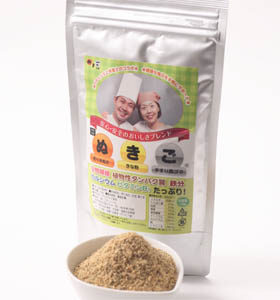認証商品
ぬきご

ぬきごは、普段の食生活ではあまり摂食されない米ぬかに、きな粉とごまをブレンドした食味の良い粉末状の食品である。
米ぬかには、ビタミン B1、ビタミン E、γ‐オリザノール、食物繊維 ※01 伊藤茂 他 2001. 酒米とう精時に発生する米ぬかの理化学的特性とその利用.愛知県農業総合試験場研究報告 33:71-76. ※02 青江誠一郎 1994. 米ぬか食物繊維の機能性について.日本醸造協会誌 89:48-52. ※03 Sawada K et al. 2019. Absorption and metabolism of γ-Oryzanol, a characteristic functional ingredient in rice bran. J Nutr Sci Vitaminol (Tokyo) 65:S180-S184. が含まれており、血中コレステロールを低下させ、便通をよくし、肥満を予防する効果が期待される ※04 Ito Y et al. 2015. Rice bran extract containing acylated steryl glucoside fraction decreases elevated blood LDL cholesterol level in obese Japanese men. J Med Invest 62:80-84. ※05 Zarei I et al. 2017. Rice bran metabolome contains amino acids, vitamins and cofactors, and phytochemicals with medicinal and Nutritional properties. Rice (NY) 10:24. 。また、免疫力を上げ ※06 Henderson AJ et al. 2012. Chemopreventive properties of dietary rice bran: current status and future prospects. Adv Nutr 3:643-653. 、血糖値を下げる ※07 Saji N et al. 2019. Rice bran derived bioactive compounds modulate risk factors of cardiovascular disease and type 2 diabetes mellitus: an updated review. Nutrients 11:2737. ※08 Masuzaki H et al. 2019. Brown rice-specific γ-Oryzanol as a promising prophylactic avenue to protect against diabetes mellitus and obesity in humans. J Diabetes Investig 10:18-25. という報告もある。
きな粉には、たんぱく質、食物繊維、イソフラボノイド ※09 今井伸二郎 2014. 青大豆抽出物の機能性について.日本食品科学工学会誌 12:625-631. が含まれており、免疫機能不活化やコレステロール低減効果が期待される。
ごまには、リグナン、セサミンなどが豊富に含まれており ※10 堀川学 他 2018. ひらけごま!見えてきたごまリグナンの生合成機構.科学と生物 11:738-746. それらが中性脂肪、LDLを低下させ、総抗酸化能、HDLを増加させるという報告がある ※11 Helli et al 2016. Effect of sesamin supplementation on cardiovascular risk factors in women with rheumatoid arthritis. J Am Coll Nutr 35:300-307. 。
ぬきご 10 g あたり、食物繊維 2.09 g , たんぱく質2.19 g, 鉄分 0.71 mg, カルシウム 35 mg, ビタミンB1 0.186 mg が含まれる。
| 認証成分 | 判定 |
|---|---|
| 食物繊維 | 栄養強調表示基準 6.0 g/100g 以上含む |
| たんぱく質 | 栄養強調表示基準 16.2 g/100g 以上含む |
| 鉄 | 栄養強調表示基準 2.04 mg/100g 以上含む |
| カルシウム | 栄養強調表示基準 204 mg/100g 以上含む |
参考文献
| 01. | 伊藤茂 他 2001. 酒米とう精時に発生する米ぬかの理化学的特性とその利用.愛知県農業総合試験場研究報告 33:71-76. | |
| 02. | 青江誠一郎 1994. 米ぬか食物繊維の機能性について.日本醸造協会誌 89:48-52. | |
| 03. | Sawada K et al. 2019. Absorption and metabolism of γ-Oryzanol, a characteristic functional ingredient in rice bran. J Nutr Sci Vitaminol (Tokyo) 65:S180-S184. | |
| 04. | Ito Y et al. 2015. Rice bran extract containing acylated steryl glucoside fraction decreases elevated blood LDL cholesterol level in obese Japanese men. J Med Invest 62:80-84. | |
| 05. | Zarei I et al. 2017. Rice bran metabolome contains amino acids, vitamins and cofactors, and phytochemicals with medicinal and Nutritional properties. Rice (NY) 10:24. | |
| 06. | Henderson AJ et al. 2012. Chemopreventive properties of dietary rice bran: current status and future prospects. Adv Nutr 3:643-653. | |
| 07. | Saji N et al. 2019. Rice bran derived bioactive compounds modulate risk factors of cardiovascular disease and type 2 diabetes mellitus: an updated review. Nutrients 11:2737. | |
| 08. | Masuzaki H et al. 2019. Brown rice-specific γ-Oryzanol as a promising prophylactic avenue to protect against diabetes mellitus and obesity in humans. J Diabetes Investig 10:18-25. | |
| 09. | 今井伸二郎 2014. 青大豆抽出物の機能性について.日本食品科学工学会誌 12:625-631. | |
| 10. | 堀川学 他 2018. ひらけごま!見えてきたごまリグナンの生合成機構.科学と生物 11:738-746. | |
| 11. | Helli et al 2016. Effect of sesamin supplementation on cardiovascular risk factors in women with rheumatoid arthritis. J Am Coll Nutr 35:300-307. |
